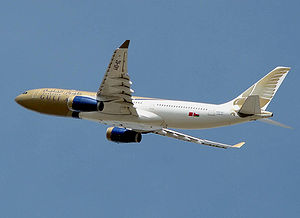
- Image via Wikipedia
Yesterday, the Brazilian navy discovered the bodies of two passengers from the Air France flight, and three additional bodies today, as well as a number of items associated with the plane, including a ticket for the flight. Items recovered include sections of wing, seats, and luggage.
The Brazilian officials said their first priority is to recover as many bodies as possible, in order to return them to the victim’s families. They also want to recover luggage items and aircraft pieces to aid in the crash probe.
Elsewhere, in the as yet mostly theoretical investigation, attention has turned to the fact that the plane received inconsistent airspeed readings from different instruments as it flew, based on the error message received. Airbus had recommended the replacement of speed-measuring instruments known as Pitot tubes on the A330. The investigation is focusing on whether external instruments may have iced over, confusing speed sensors and leading computers to set the plane’s speed too fast or slow. “Pitot tubes, protruding from the wing or fuselage of a plane, feed airspeed sensors and are heated to prevent icing. A blocked or malfunctioning Pitot tube could cause an airspeed sensor to malfunction and cause the computer controlling the plane to accelerate or decelerate in a potentially dangerous way.”
Air France had already replaced the Pitots on another Airbus model, the 320, after its pilots reported similar problem. Air France decided to increase the inspection frequency for its A330 and A340 jets’ Pitot tubes, but that it had been waiting for a recommendation from Airbus before installing new Pitots.
If this is indeed the case, it would be reminiscent of another disaster, Aeroperu 603, in 1996, from Lima to Santiago, where the computers were putting out contradictory information on airspeed and altitude. The cause…masking tape placed over the static ports(responsible for those sensors. The Boeing 757 did not have maintenance covers for the ports during cleaning, and the procedure was to place tape over them. An employee in this case, neglected to remove it afterward. He had also used standard duct tape instead of bright reflective tape, so a pre-flight inspection did not spot the mistake.
Without proper information being fed to the autopilot and the pilots, the plane could have taken improper actions which led to its downing.
Related articles by Zemanta
- Air France plane crash: two bodies recovered from Atlantic says Brazil’s air force (telegraph.co.uk)
- Air France Crash Bodies To Be Examined (news.sky.com)
- Bodies Found From Air France Plane Crash (news.sky.com)
- Brazilian Military Finds Bodies From Air France Flight (abcnews.go.com)
- Air France Was Warned of Speed Sensor Issue (nytimes.com)
![Reblog this post [with Zemanta]](http://img.zemanta.com/reblog_e.png?x-id=15e5540c-7725-4b4a-91e6-1396c94f6374)